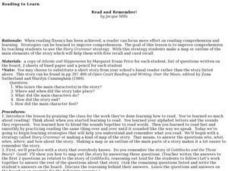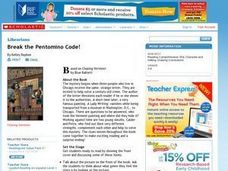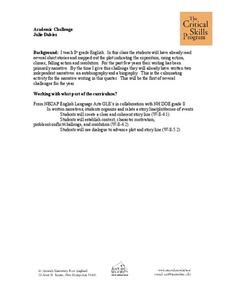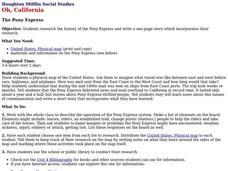Curated OER
Multimedia Book Reports
Students read a chapter book of 100-200 pages in length. They create a story map and multimedia book report. Pupils review the elements of a story map such as: characters, setting, problem, important events, solution, etc.) Students...
Curated OER
Figurative Language and Symbolism
Young scholars identify figurative language and symbolism in poetry as well as prose. In this literary elements activity, students read and discuss the role of symbolism in Yellow Man by Moonlight, A Christmas Carl, The House of Wings,...
Curated OER
Read and Remember - Story Grammar
Students use the Story Grammar strategy to outline the main elements of the story which will help them with free recall and cued recall. The strategy includes: identifying the main characters in the story, recalling where and when the...
Curated OER
Read a Transportation Story
Eighth graders research the career of Arctic transportation. In this arctic transportation lesson, 8th graders read a book about Arctic truck travel and review the historical aspects of transporting goods in the Arctic. Students review...
Curated OER
Story Plot Flow Map
In this story plot flow map worksheet, students complete the flow chart through short answers writing about the beginning, middle, climax, and conclusion of the story.
Curated OER
Writing a Children's Book -- Young Authors
High schoolers practice their writing skills by creating a children's book. They integrate five elements of short stories into the narrative. They share their stories with their book buddies.
Curated OER
Cause and Effect
Young scholars identify cause and effect relationships in a short story. After reading a short story, they participate in a discussion of how one event in a story can lead to several others. Students are then paired for a matching task...
Curated OER
Break the Pentomino Code!
Learners read and analyze the book, Chasing Vermeer. They discuss the main story elements, analyze how pentominoes are important to the story, use a pentomino code to decipher a message, and create a secret code of their own.
Curated OER
Using Inspiration Software to Explore Characters In Stories
Students identify characters, their qualities, and examples of their qualities and use Inspiration to organize them in a clear and understandable format. After a lecture/demo, students use the program on the next story by themselves.
Curated OER
The Time I Got Lost
Third graders go through the writing process but substitute paper and pencil with the computer to create a story about "The Time I Got Lost".
Curated OER
In the Shadow of the Mountain by Helen Naylor
In this comprehension check worksheet, students respond to 44 matching, true/false, fill in the blank, and short answer questions before reading, while reading, and after reading In the Shadow of the Mountain by Helen Naylor in order to...
Curated OER
Animaters and Lego Mania!
Students use various technology elements to storyboard and create an animal animation story based on a nonfiction story they've read. In this animation story lesson plan, students work in groups and read nonfiction animal stories....
Curated OER
Legends of the Navajo People
Second graders are read a story in which they begin to examine Native American legends. Using different legends, they discuss how they affected the future people of native peoples. They write a short story on the information they gathered.
Curated OER
Splendid China: Chinese Folktales
Students investigate Chinese culture by reading their folk tales. In this creative writing lesson, students practice identifying the different elements in a folk tale and examine the related vocabulary. Students organize...
Curated OER
Storytelling
Students compose a story and tell it to the class. In this storytelling lesson, students work in small groups to create an illustrated story. Students are given a checklist of elements to include in the...
Curated OER
Most Wanted Villians
Students review the characteristics of various characters in fairytales. As a class, they review the story details and create a concept map using a software program. They create their own wanted poster of the villians in the fairytale to...
Curated OER
Why Not Visit My Country?
Learners research a country using the Travel Languages Web site. Using MS Publisher, they create a travel flyer about the country. Using Inspiration, they develop a concept map of what they learned about their country.
Curated OER
Comprehension
Fifth graders take part in a panel discussion. In this character lesson students show their understanding of the connection between events in a story and the development of characters. Students provide evidence from the story to support...
Curated OER
Pre Writing Strategies
Second graders review story mapping along with characters, setting, problem, events, and solution. They view pictures and tell the story of their picture orally then they write rough drafts and final copies of their stories in the...
Curated OER
Catch Me If You Can: Over and Under
Students read a story. In this vocabulary skills lesson plan, students read The Gingerbread Man, use flannel cut outs to re-enact the gingerbread man running over and under.
Curated OER
An Ancient Greek and Roman Festival
Third graders label a map of ancient Greek and Roman civilizations and do a written report on one element of these two cultures. They participate in discussions of food, farming, daily life and government (among others). Students use the...
Curated OER
We Thank You, Veteran!
Fifth graders use information from videos, picture books, and relatives' military backgrounds to write a short or extended message of gratitude on a greeting card for local veterans.
Curated OER
The Pony Express
Fourth graders reasearch the history of the Pony Express on the internet or they can use books from the school or public library. They write a one-page story which incorporates their research. They share their stories with the class by...
Curated OER
Poetry
Fourth graders participate in reading and listening to poetry. They are exposed to a variety of poems and examine and identify basic elements of poetry. They write their own poems and recite a poem with enthusiasm, expression, and props.























